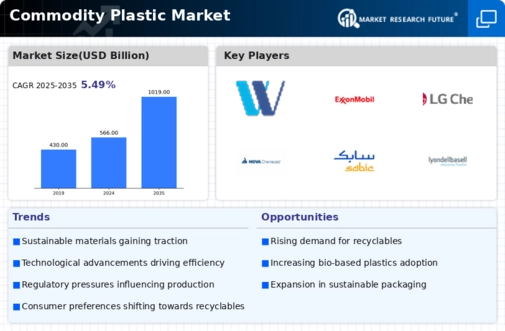Market Trends
Key Emerging Trends in the Commodity Plastic Market
The commodity plastic market, encompassing plastics like polyethylene, polypropylene, polyvinyl chloride, and polystyrene, is experiencing several significant trends driven by factors such as economic growth, technological advancements, environmental concerns, and regulatory changes. Commodity plastics are widely used in various industries for packaging, construction, automotive, electronics, and consumer goods.
One notable trend in the commodity plastic market is the increasing demand for sustainable and recyclable plastic materials. With growing awareness of environmental issues such as plastic pollution and climate change, there is a push towards reducing plastic waste and adopting more eco-friendly alternatives. Manufacturers are responding by developing biodegradable plastics, recycled plastics, and bio-based plastics derived from renewable sources. Additionally, there is a growing emphasis on closed-loop recycling systems and circular economy principles to minimize the environmental impact of plastic production and consumption.
Technological advancements are driving innovation in the commodity plastic market, leading to the development of high-performance materials with enhanced properties. Additive manufacturing technologies such as 3D printing are revolutionizing plastic fabrication processes, enabling the production of complex and customized plastic components for various applications. Moreover, advancements in polymer chemistry and processing techniques are improving the strength, durability, and thermal stability of commodity plastics, expanding their utility in demanding industrial and engineering applications.
The COVID-19 pandemic has had a significant impact on the commodity plastic market, influencing consumption patterns, supply chains, and regulatory frameworks. The surge in demand for personal protective equipment (PPE), medical devices, and packaging materials during the pandemic has led to increased production and consumption of commodity plastics. However, disruptions in global supply chains, trade restrictions, and logistical challenges have also posed constraints on the availability of raw materials and distribution channels for plastic manufacturers.
Consumer preferences and purchasing behavior are evolving, influencing market trends in the commodity plastic industry. There is a growing demand for lightweight, durable, and aesthetically pleasing plastic products across various sectors, driven by factors such as convenience, affordability, and lifestyle preferences. Moreover, changing consumer attitudes towards sustainability and environmental responsibility are prompting brands and retailers to adopt eco-friendly packaging solutions and reduce the use of single-use plastics.
Regulatory changes and policy initiatives are shaping the regulatory landscape of the commodity plastic market, impacting production, distribution, and consumption patterns. Governments worldwide are introducing measures to mitigate plastic pollution, reduce plastic waste, and promote recycling and circular economy practices. These regulations include bans on single-use plastics, restrictions on plastic packaging, extended producer responsibility (EPR) schemes, and incentives for using recycled materials. Compliance with regulatory requirements and adherence to sustainability standards are becoming increasingly important considerations for plastic manufacturers and end-users.
The Asia-Pacific region dominates the global commodity plastic market, driven by rapid industrialization, urbanization, and infrastructure development in countries like China, India, and Southeast Asia. The region is a major producer and consumer of commodity plastics, supported by robust manufacturing capabilities, growing consumer markets, and favorable economic conditions. Moreover, increasing investments in petrochemicals and plastics production capacity are further propelling market growth in the Asia-Pacific region.
North America and Europe are also significant markets for commodity plastics, characterized by stringent regulatory standards, advanced recycling infrastructure, and a strong emphasis on sustainability and environmental stewardship. These regions are witnessing growing demand for recycled plastics, bio-based plastics, and alternative materials as consumers and businesses seek to reduce their carbon footprint and environmental impact.












Leave a Comment